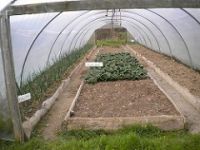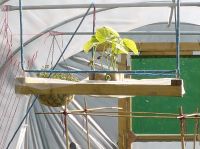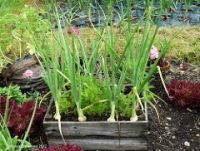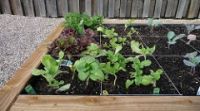Tips For Making The Most of the Space in your Polytunnel or Greenhouse
Make a Plan
First things first. When it comes to making the most of the space in your polytunnel or greenhouse throughout the year, it is important to make a plan. While there can always be some room for spontaneity in the garden and sometimes experimentation can lead to unexpected results and make things take a surprising turn, it is important to have a plan in place. Without a solid plan for what you will sow and plant, where and when, you are likely to end up with empty space. Forward thinking is essential. If you want to be eating from your polytunnel in the middle of winter, for example, you will need to start planning the summer before.
 Optimise Your Layout
Optimise Your Layout
Many polytunnels follow the same, simple layout – one path with two beds down each side. But for polytunnels that are wider than around 8ft-10ft, it may be better to have two paths so that you can fully reach, and fully optimise the use of, each bed, right to the edges. Another option is to have a path to one side, with side branches leading off that – this layout can also increase the amount of 'edge' available to you for diverse growing and help you to make the most of the space you have.
 Think Vertically
Think Vertically
You may fall into the trap of thinking about your polytunnel as a space on the ground – but the space within the tunnel also extends vertically, with a higher space in the middle than there is at the sides. Think about how you can make the most of that space, not only by growing vining plants up supports but also by utilising the crop bars to hang some staging that can be raised and lowered. You can also grow plants in vertical garden structures and in baskets or other hanging containers, which can really increase the amount of growing space you have for quick crops like salad leaves.
 Use Polycultures
Use Polycultures
Having row upon row of carrots then row upon row of brassicas, then a couple of rows of onions may be the traditional way of doing things for many gardeners. But actually, your crops could benefit from being planted not as individual distinct crops but in a polyculture. Some crops may still be in rows (for ease of weeding etc.) but, for example, carrots will have some onions as companions and tomatoes may be underplanted with basil. Rows of peas or beans may be grown between brassicas to aid them with their nitrogen fixing properties. Companion planting and the creation of polycultures will not only allow plants to help each other out, it will also help you make the most of your space and increase your overall yield over a given area.
 Use all the Time as Well as all the Space
Use all the Time as Well as all the Space
Think about making the most not only of the physical space but also of the whole span of time in each gardening year. For example, quick growing crops such as radishes or cut-and-come-again lettuce are perfect for sneaking in a little bonus harvest when sown alongside slower growing crops such as parsnips or cabbages. The former will be eaten up by the time the latter need the space.